Interview with Belinda Scarlett
BELINDA SCARLETT, theatre costume and set designer and ecclesiastical textile artist
INTERVIEW BY JONATHAN EVENS
Belinda Scarlett is an English highly regarded, though modest, theatre costume and set designer and ecclesiastical textile artist. She studied Textiles at Camberwell School of Art and Stage Design at the Slade School of Fine Art before going on to design the costumes for Christopher Bruce's “Ghost Dances” (1981) which is one of the most celebrated pieces of its generation.
Since its debut at the Theatre Royal Bristol, “Ghost Dances” has been performed by dance companies around the world. It has twice been revived by Rambert Dance Company and has been shown on Channel 4 and BBC 2. Her other costume designs include: “Figures of Wind” and “Room to Dance” and others (for more info see at the bottom of the interview). Set and Costume designs include “Eight Songs for a Mad King” by Peter Maxwell Davies and “Aventures et Nouvelles Aventures” by Ligeti for Theatre Musical De Paris and Ensemble Intercontemporien, conducted by Pierre Boulez at the Chatelet Theatre, Paris.
Her ecclesiastical work includes altar cloths or frontals for Westminster Abbey, Lambeth Palace Chapel, Winchester Cathedral, York Minster and Vestments for St Paul’s Cathedral, Gloucester Cathedral, Lambeth Palace Chapel, among others. Her work is illustrated in three books by Beryl Dean MBE on aspects of Ecclesiastical Textiles.
JE: How did you become an Ecclesiastical Textile artist?
BS: I have always loved painting and drawing. Masaccio’s ‘The Expulsion from Paradise’ was one of the very first paintings I saw. That registered with me. The dejection of the two figures touched me. That was where my art began. I studied Textiles at Camberwell School of Art followed by Stage Design at the Slade School of Fine Art. I wanted to work as a designer and the opportunity came through Christopher Bruce who had been a wonderful dancer with Ballet Rambert and was now working as a choreographer. He was appalled by the murder of the Chilean poet and musician Victor Jara by General Pinochet and made a work called “Ghost Dances” in response. It’s a tribute to all missing people who happen to be in the wrong place at the wrong time. The ghost dancers refer to the South American Indian shamans who were thought to contact the spirits of the dead. I made the costumes. It’s a wonderful piece which is as relevant today as when first staged.
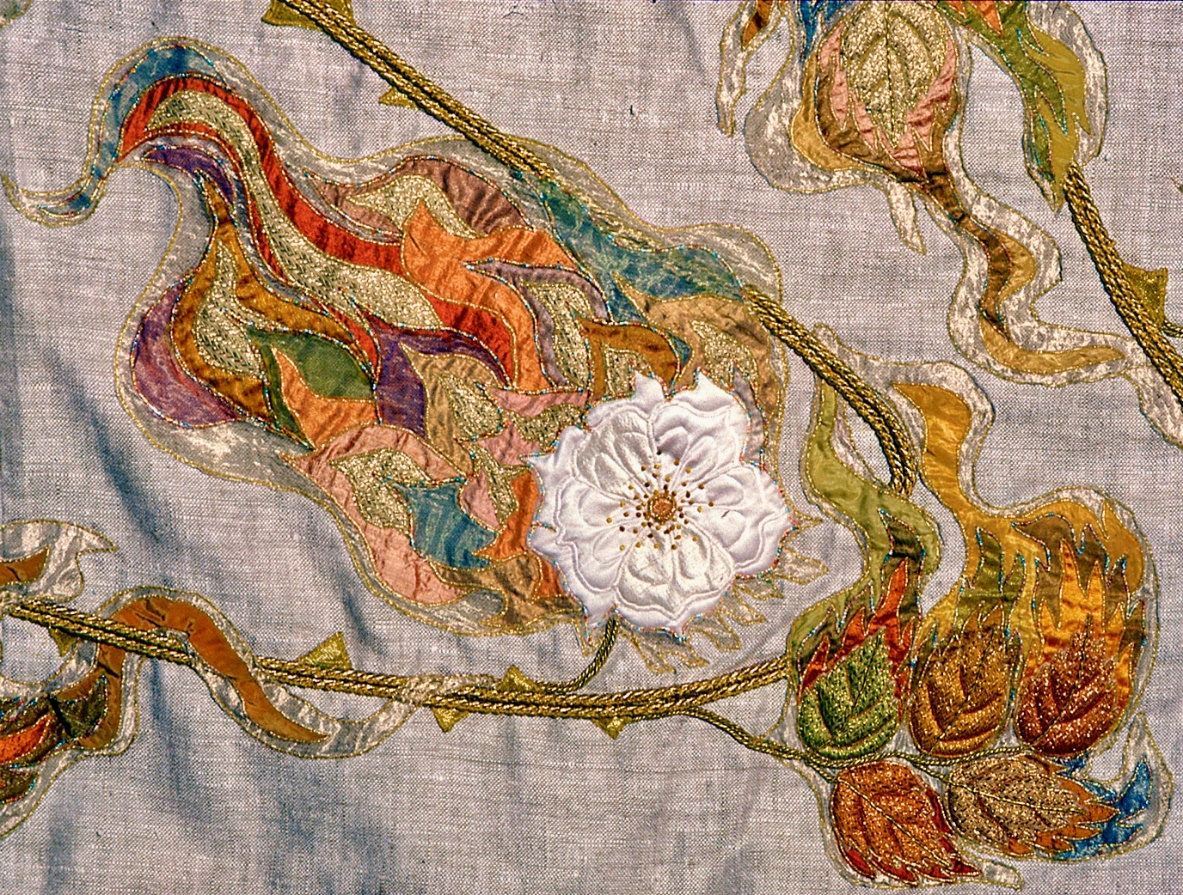
Westminster Abbey altar frontal (detail), © Malcolm Crowthers
Pamela Tudor-Craig saw my work in our Degree Show at the Slade and said to me ‘Belinda, the Church needs you.’ I thought no more of it as I was involved in theatre, but five years later she commissioned me to make an altar frontal for Westminster Abbey following her marriage to Sir John Wedgwood. She was living at Little Gidding at the time, so the theme she gave me was ‘All shall be well and / All manner of thing shall be well / When the tongues of flame are in-folded / Into the crowned knot of fire / And the fire and the rose are one.’ What interested me about the commission was using different fabrics like shot silks and gauzes so that it was barely perceptible where leaves ended and flames began.
At the Slade we did a project with John Collins, the scene painter at the Royal Shakespeare Company at Stratford. He taught us how to square up an elaborate architectural design by Piranesi. That turned out to be very helpful for me. I think it was through that, that I haven’t been daunted by large spaces because quite a few of the Cathedrals where I have worked have been large spaces.
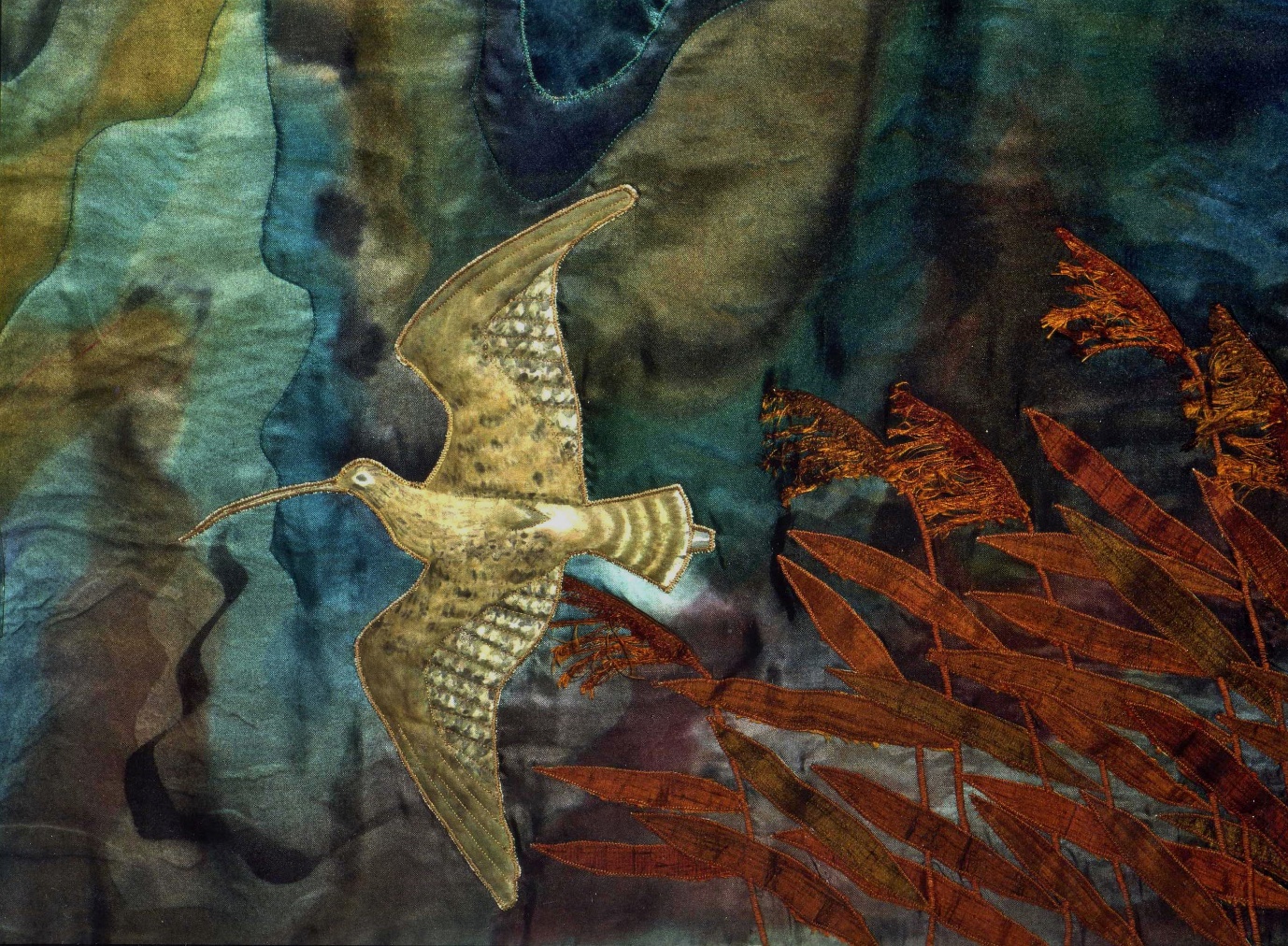
St John the Baptist, Snape altar frontal (detail)
A commission at St John the Baptist, Snape then came through a friend of Peter Burman who was involved in church conservation. The person who commissioned that piece encouraged me constantly by saying ‘I am not worried, Belinda, I know it will be beautiful.’
JE: Can you tell us about your connection with Beryl Dean? Are there other artists who have been an inspiration for you?
BS: I was trying to work out when I met Beryl. I’m not sure. She must have seen my work and was arranging a big exhibition at St Paul’s Cathedral and asked me to put some work in. She was very encouraging and supportive of my work which is different in every possible way from hers.
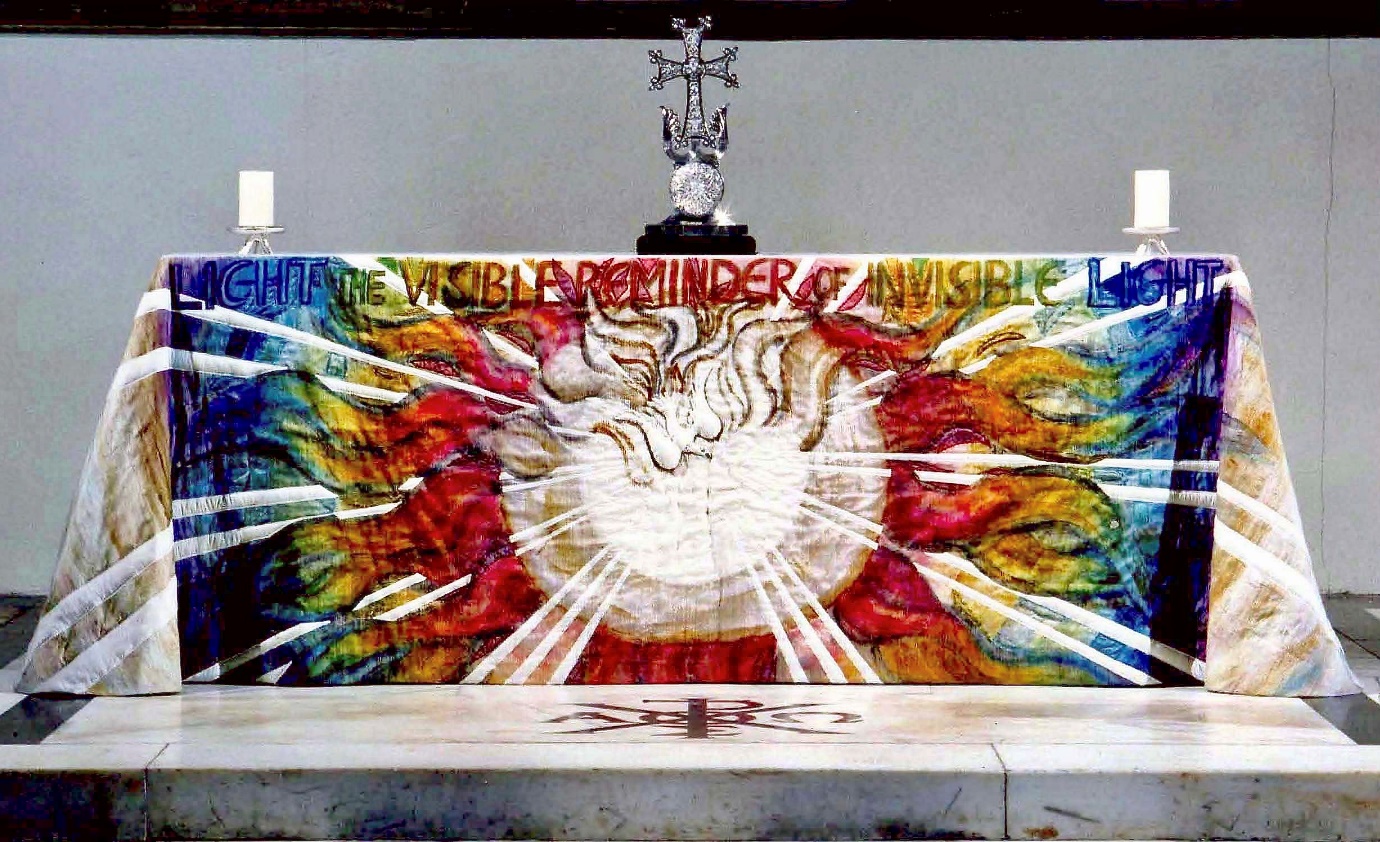
Lambeth Palace Chapel altar frontal, © Malcolm Crowthers
So, I can’t think why she should but after the show she wrote three books and included my work in them. She wrote: “Belinda Scarlett’s inspiration tends to be intellectual and when designing the altar cloth for Lambeth Palace Chapel she was influenced by T. S. Eliot’s ‘The Rock 1X ; ‘Light the visible reminder of invisible light.’ She explores light as a spiritual image; cosmic light with its creative power and energy radiates from the still centre, while the dove of the Holy Spirit illuminates each human soul with the fire of love.” I admire her. She forged a way for others, like me, to follow.
I love the stillness of Piero della Francesca’s ‘Baptism of Christ’; Bellini, Giotto, Titian. Also the passion and humanity in the works of Rembrandt and Van Gogh. I like the early heads of Frank Auerbach and the heads made by Emily Young. The stained glass of Thomas Denny. To me, Barbara Hepworth’s ‘Hospital drawings’ are very beautiful in their pared downness, the intense focus of concentration on the eyes and hands.
JE: To what extent are you thinking about your work in its setting when designing for churches and to what extent thinking primarily about your theme?
BS: The work I do should relate to its surroundings. The setting is both the architecture and the wider context, at Snape, the estuary and the water. The cloth at Snape whose theme ‘God is the still point at the centre’ is taken from Julian of Norwich, also relates to Benjamin Britten who wrote ‘Curlew River’ there. It is important to me that the work should feel at home in the space.
JE: You make frequent use of text in your work. Does inspiration begin for you with words or images?
BS: I do like to find a theme that resonates. Like the Winchester cloth which celebrates the alliance between religion and conservation. The Dean of Winchester, Trevor Beeson, had been at Westminster Abbey and knew me. I was at St James’ Piccadilly one day where someone said that today in Winchester Cathedral is a wonderful service bringing together conservationists and other religions including Sufis, Hindus, Buddhists. In talking with the Dean about my hopes for this work to be my ecological offering, he agreed saying “ecology plus” and put me in touch with Lancelot Andrewes prayers. I used ‘Being beyond all being / Existence uncreate / Framer of the Universe’ from the Private Prayers of Lancelot Andrewes.
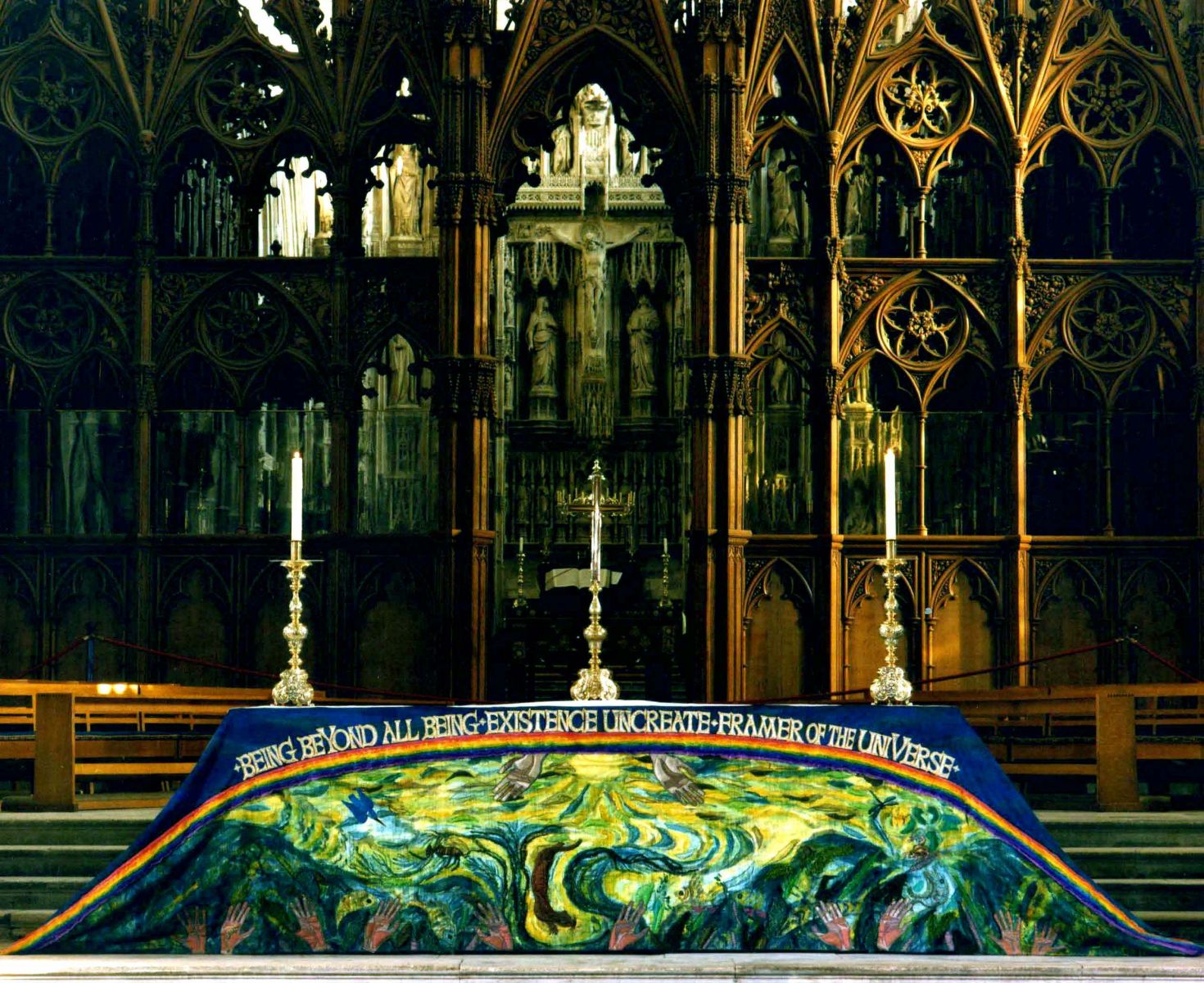
Winchester Cathedral altar cloth, © Malcolm Crowthers
All things depend on each other, and hands are used here to indicate this interdependence. The sun, the supreme cosmic power, is a symbol of God, the source of spiritual light and love. The river was chosen because of the ancient connection between Winchester and the River Itchen. Water sustains life. Greenness suggests growth, renewal. An otter, a kingfisher, a frog, a dragon fly and fishes appear. The rainbow is a symbol of reconciliation, the meeting of heaven and earth. Darkness suggests infinity, the beyond.
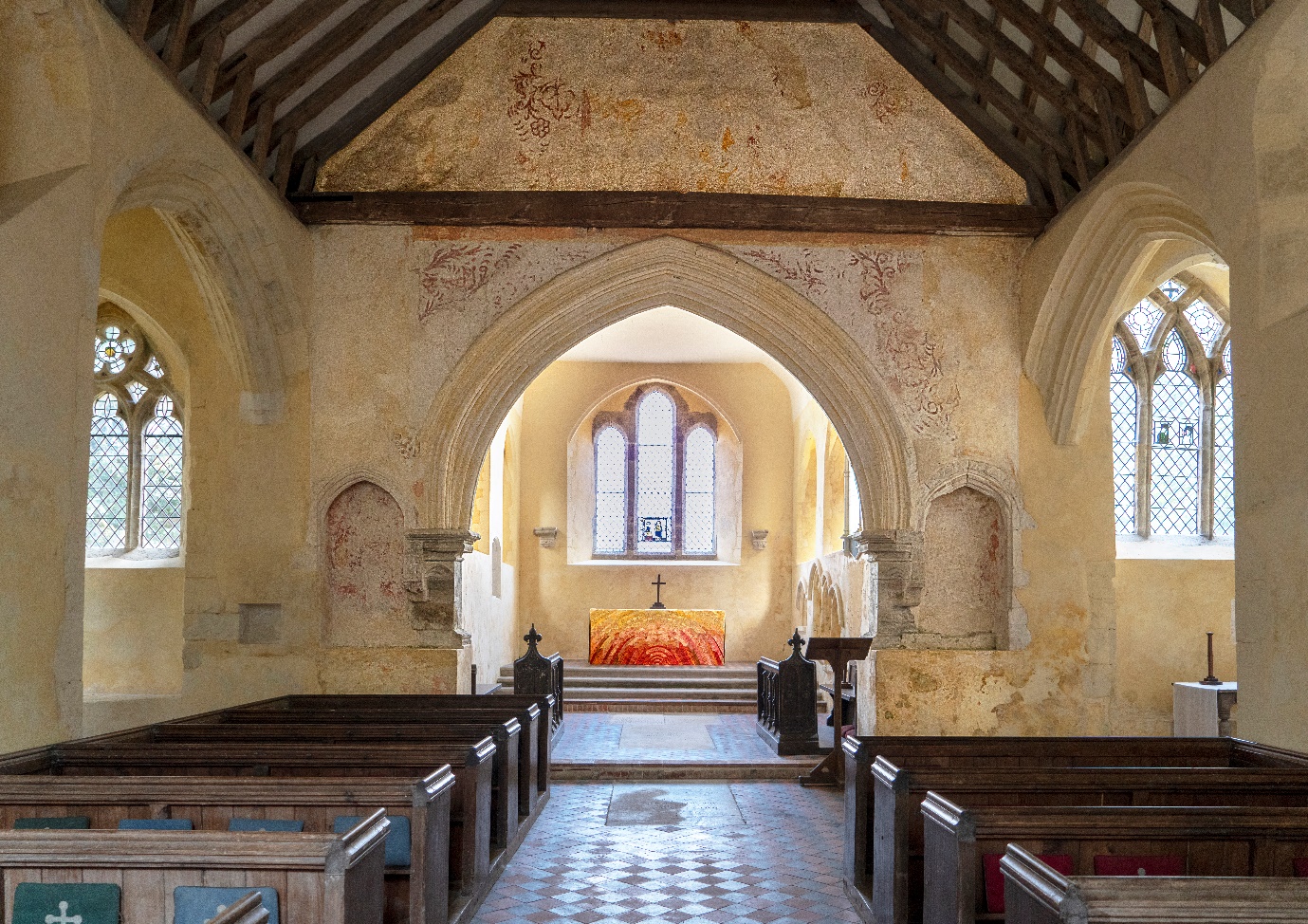
St Mary North Stoke altar frontal, © Wendy Eve
I took a more abstract approach at St Mary North Stoke, an ancient church in the Downs in Sussex. ‘My soul doth magnify the Lord’ was the theme expressed through the movement from a tiny central point at ground level expanding upwards and outwards in praise and thanksgiving.
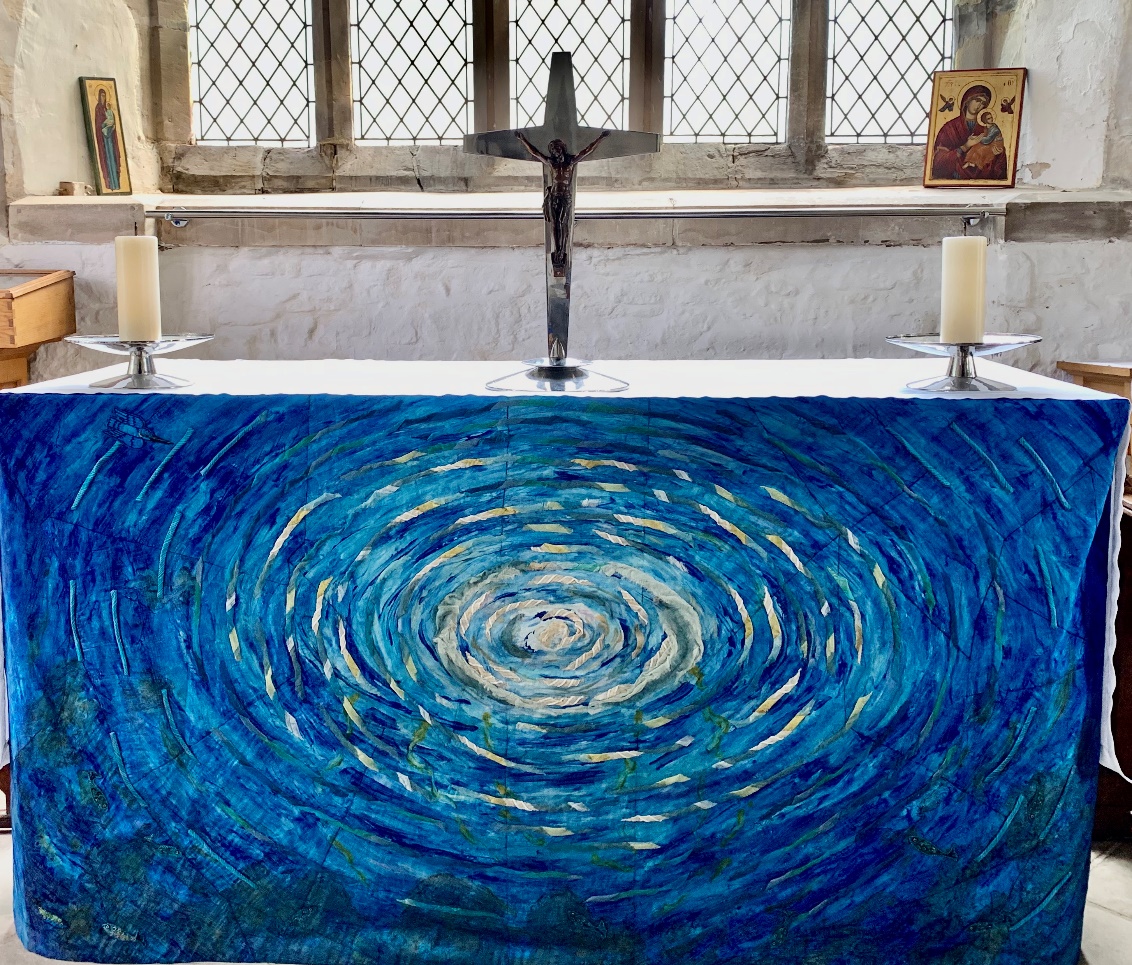
St Mary’s Broughton Astley altar frontal
Another example is of an altar frontal for a church near Leicester, St Mary’s Broughton Astley. Although there is no text, ‘Spring of living water’ was the starting point. This work was given in memory of a man who had meningitis at the age of three. He was placed in an oxygen tent which caused brain damage leaving him unable to express any emotion. He was given hydro-therapy in the hope it would give him some release and relief. I am interested in what lies beneath the surface and I am sure much lay below the surface of this man’s life.
I tried to convey a sense of the ‘beneath’, revealing pebbles, rays of light and small fishes. Initially I made drawings from a water feature. The sun was shining, it was low in the sky, and it somehow went through the ripples on the surface to reveal what’s underneath in the most beautiful way. The ripples became ripples of golden light below the surface. I wanted a layered feeling and used moire silk which has a watermark. I painted this ground with dyes, building up the intensity of colour, then worked into it with other fabrics, appliqued. I very often use shot silks as they catch and reflect the light in different ways according to the light source. Gauzes also give a sense of translucency. Sometimes, I include stitching and hand embroidery.
JE: Nature and poetry seem to be recurring themes within your work. Can you tell us about their significance for you as an artist?
BS: I do love nature and poetry. They open the mind and expand the heart. Kahil Gibran ‘The Prophet’ ‘Work is love made visible,’ ‘It is when you give of yourself that you truly give’; Rilke ‘Letters to a Young Poet’; Freya Stark essays ‘Perseus in the wind’; Ettie Hillesum; Van Gogh’s Letters; John Donne ’Batter my heart three personned God’; Thomas Traherne ‘You never Enjoy the World aright, till the Sea itself floweth in your veins, till you are Clothed with the Heavens, and Crowned with the Stars: and perceive yourself to be the Sole Heir of the whole World: and more then so, because Men are in it who are evry one Sole Heirs, as well as you. Till you can Sing and Rejoyce and Delight in GOD, as Misers do in Gold, and Kings in Scepters, you never Enjoy the World’; R S Thomas ‘The Bright Field’; Keats ‘Ode to a Nightingale’; George Herbert ‘Love bade me welcome but my soul drew back’; Gerard Manley Hopkins seems to be text and image - ‘God’s Grandeur’, ‘Pied Beauty’; ‘The Windhover’; Henri Nouwen ‘The Return of the Prodigal Son’; Meister Eckhart; William Blake ‘To see the World in a Grain of Sand / And a Heaven in a Wild Flower, / Hold Infinity in the palm of your hand, /And Eternity in an hour.’
JE: Your altar frontals are not simply frontals but instead are all-over designs. What are you aiming for by designing for the back and well as the front of the altar?
BS It’s actually prosaic, the fact that they can be turned with the seasons. For example, the Lambeth altar cloth is light one side and dark the other. The dark being for All Souls Day, Advent and Lent. They didn’t ask for that, it was my idea because it seemed a waste that it should just be calico across the back! Also, the Winchester altar cloth, the back of that is the river at night with reflections that suggest the immensity of the universe. The green Westminster Abbey altar cloth relates all the way round. The order of the far side “I am Alpha and Omega the beginning and the end” breaks down leading to “Behold I make all things new” which concerns the possibility of finding wholeness within the brokenness and often fragmentary state of our being and of our world.
JE: Altar frontals are static works while vestments move with their wearer. Does this difference influence your vestment designs at all or are you primarily thinking of the vestments in relation to the frontal?
BS: Yes, to both again. I work in relation to the altar frontal design and movement. Through my work in dance, I am aware as to how the design will work on the body in movement. The Gloucester Cathedral Copes are a good example. Copes are usually semicircular. However, these are more than a semicircle as I took the basis of their design from the fan tracery of the vaulting in the cloisters. These wedge-shaped pieces when joined form an increased distance around the circumference allowing for greater movement in procession.
When I’m asked to make vestments having made an altar cloth or frontal, then they’re asking that they should relate. In the case of Lambeth, it was an interesting challenge for me to get the designs for the red, the green, and the white vestments to work in different ways in relation to the light side. I wanted a different dynamic in each one. The green one was rounded and calm and peaceful like green can be. The white one was radiating again active I suppose you can say. The red one was flames and then the purple one relates to the dark side and suggests a figure on the cross.
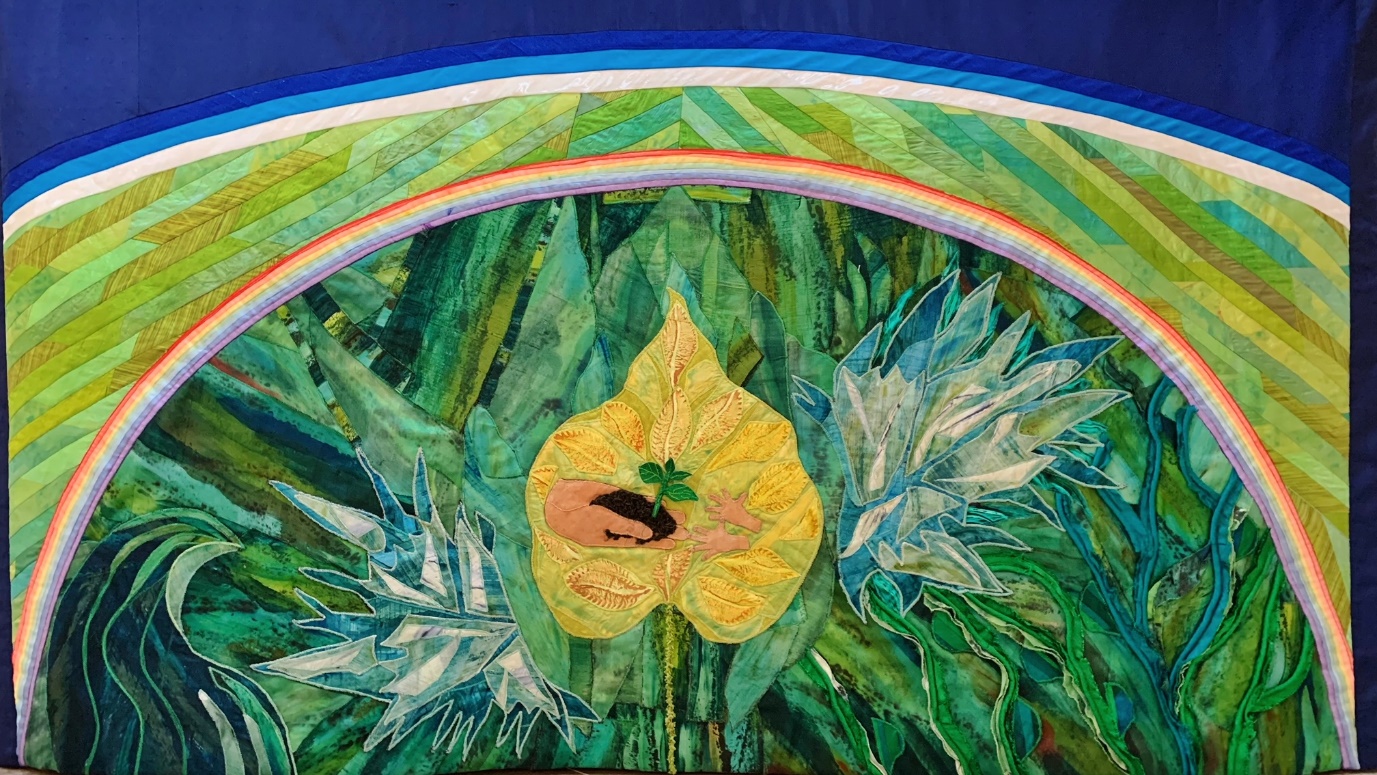
St Philip and St James Leckhampton, Cheltenham, altar cloth
JE: What are you currently working on or what has been your most recent commission?
BS: I have just completed an altar cloth for St Philip and St James Leckhampton, Cheltenham. This was worked on four sides and included a set of vestments in the four liturgical colours. Awareness of climate change was the basis for this work. The intense vibrant band of turquoise light that encircles Planet Earth as seen from space fills me with awe. As climate change is affecting every corner of this planet it seemed appropriate to set each of the four panels within the infinite dark of space and to evoke the four elements: Water, Air, Fire, Earth. Water shows the currents of the oceans. Air the dawn of a new day, jetstream, a feather. Fire, refining fire that both destroys and brings new life. Earth is framed by a rainbow. The focus is in the central image of the adult’s hand holding soil in which a seedling has sprouted. This is offered to a little child whose hands are eager to receive it. May the beauty and the wonder of creation of this precious world we inhabit be here for generations to come.
*******
Belinda Scarlett is an English highly regarded, though modest, theatre costume and set designer and ecclesiastical textile artist. She studied Textiles at Camberwell School of Art and Stage Design at the Slade School of Fine Art before going on to design the costumes for Christopher Bruce's “Ghost Dances” (1981) which is one of the most celebrated pieces of its generation. Since its debut at the Theatre Royal Bristol, “Ghost Dances” has been performed by dance companies around the world. It has twice been revived by Rambert Dance Company and has been shown on Channel 4 and BBC 2. Belinda's costume designs were shown in the exhibition to celebrate “Rambert at 75” at the Theatre Museum, Covent Garden in 2001.
Her other costume designs include: “Figures of Wind” and “Room to Dance” choreographed by Cliff Keuter for Ballet Rambert; “The Beggars’ Opera” by John Gay and “Punch and Judy” by Harrison Birtwistle for Opera Factory London, also shown on Channel 4; “La Callisto” by Cavalli and “The Knot Garden” by Sir Michael Tippett for Opera Factory London Sinfonietta at the Royal Court Theatre, also shown on Channel 4. Set and Costume designs include “Eight Songs for a Mad King” by Peter Maxwell Davies and “Aventures et Nouvelles Aventures” by Ligeti for Theatre Musical De Paris and Ensemble Intercontemporien, conducted by Pierre Boulez, at the Chatelet Theatre, Paris.
Her ecclesiastical work includes altar cloths or frontals for Westminster Abbey, Lambeth Palace Chapel, Winchester Cathedral, York Minster and Vestments for St Paul’s Cathedral, Gloucester Cathedral, Lambeth Palace Chapel, among others. Her work is illustrated in three books by Beryl Dean MBE on aspects of Ecclesiastical Textiles. https://belindascarlett.com
Revd Jonathan Evens is Team Rector at the churches of Wickford and Runwell, England. He is co-author of ‘The Secret Chord,’ an impassioned study of the role of music in cultural life written through the prism of Christian belief. He blogs at https://joninbetween.blogspot.com/


